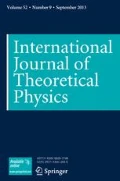Abstract
The similarity of the commutation relations for bosons and quasibosons (fermion pairs) suggests the possibility that all integral spin particles presently considered to be bosons could be quasibosons. The boson commutation relations for integral spin particles could be just an approximation to the quasiboson commutation relations that contain an extra term. Although the commutation relations for quasibosons are slightly more complex, it is a simpler picture of matter in that only fermions and composite particles formed of fermions exist. Mesons are usually referred to as bosons, but they must be quasibosons since their internal structure is fermion (quark) pairs. The photon is usually considered to be an elementary boson, but as shown here, existing experiments do not rule out the possibility that it is also a quasiboson. We consider how the quasiboson, composite nature of such a photon might manifest itself.
Similar content being viewed by others
REFERENCES
Bjorken, J. D. and Drell, S. D. (1965). Relativistic Quantum Fields, McGraw-Hill, New York.
Blatt, J. M. (1964). Theory of Superconductivity, Academic Press, New York, 414 pp.
Bohr, N. and Rosenfeld, L. (1950). Field and charge measurements in quantum electrodynamics. Physical Review 78, 794–798.
Close, F. E. (1979). An Introduction to Quarks and Partons, Academic Press, London, 359 pp.
Coblentz, W. W. (1916). Constants of spectral radiation of a uniformly heated inclosure or so-called black body, II. National Bureau Standards (United States) Bulletin 13, 459–477.
Ehrenfest, P. and Oppenheimer, J. R. (1931). Note on the statistics of nuclei. Physical Review 37, 333–338.
Feltgen, R., Kirst, H., Kohler, K. A., Pauly, H., and Torello, F. (1982). Unique determination of He 2 ground state potential from experiment by use of a reliable potential model. Journal of Chemical Physics 76(5), 2360–2378.
Huang, K. (1963). Statistical Mechanics, Wiley, New York.
Koltun, D. S. and Eisenberg, J. M. (1988). Quantum Mechanics of Many Degrees of Freedom, Wiley, New York.
Landau, L. D. (1948). The moment of a 2-photon system. Doklady Akademiia Nauk USSR 60(2), 207–209.
Landau, R. H. (1996). Quantum Mechanics II, Wiley, New York.
Lipkin, H. J. (1973). Quantum Mechanics, Chap. 6, North-Holland, Amsterdam.
Messiah, A. M. L. and Greenberg, O. W. (1964). Symmetrization postulate and its experimental foundation. Physical Review B 136, 248–267.
Pauli, W. (1940). The connection between spin and statistics. Physical Review 58, 716–722.
Perkins, W. A. (1965). Neutrino theory of photons. Physical Review B 137, 1291–1301.
Perkins, W. A. (1972). Statistics of a composite photon formed of two fermions. Physical Review D: Particles and Fields 5, 1375–1384. Perkins, W. A. (1999). The ¯pp!º0º0 puzzle. hep-th/9911009, 9 pp.
Perkins, W. A. (2000). Interpreted history of neutrino theory of light and its future. In Lorentz Group, CPT and Neutrinos, A. E. Chubykalo, V. V. Dvoeglazov, D. J. Ernst, V. G. Kadyshevsky, and Y. S. Kim, eds., World Scientific, Singapore, pp. 115–126.
Sahlin, H. L. and Schwartz, J. L. (1965). The many body problem for composite particles. Physical Review B 138, 267–273.
Veltman, M. (1994). Diagrammatica, The Path to Feynman Rules, University Press, Cambridge.
Von Baeyer, H. C. (1964). Kaon decays and pion statistics. Physical Review B 135, 189–190.
Yang, C. N. (1950). Selection rules for the dematerialization of a particle into two photons. Physical Review 77, 242–245.
Author information
Authors and Affiliations
Rights and permissions
About this article
Cite this article
Perkins, W.A. Quasibosons. International Journal of Theoretical Physics 41, 823–838 (2002). https://doi.org/10.1023/A:1015728722664
Issue Date:
DOI: https://doi.org/10.1023/A:1015728722664



